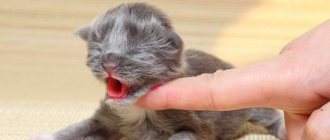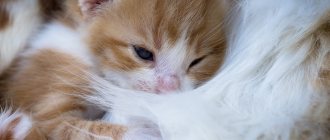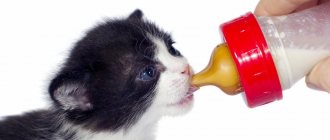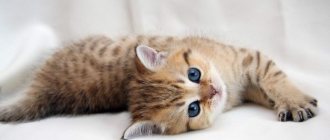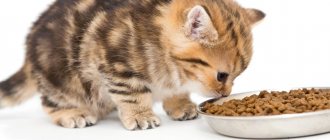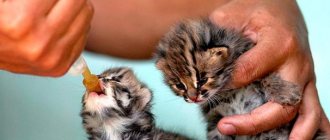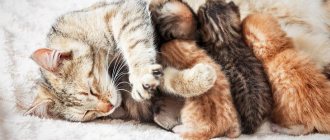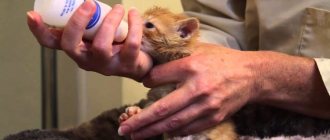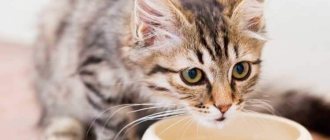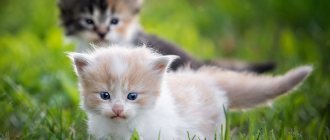After reading the material, you will find out whether it is possible to feed milk to kittens and adult cats, about the dangers and benefits of milk for the cat’s body. In the article, we talked about the types of milk in a kitten’s diet and how you can feed a kitten left without a mother. We also figured out how to identify lactose intolerance in animals.
The classic image of kittens lapping milk from a bowl is familiar to many from childhood. Therefore, many owners often give it to kittens first. However, it is important to understand that this is not necessary and milk for kittens can be a source of problems.
Small and adult cats love milk very much
Nutritional features of kittens
For the first two months of their lives, kittens get everything they need from cat's milk. At this age, they digest their mother’s milk well thanks to the enzyme lactase. This enzyme is necessary to break down the lactose contained in milk. With age, the production of lactase in the pet’s body decreases, but the animal’s appetite for milk may remain.
Month-old kittens gradually begin to switch to solid food, trying to eat meat products little by little with the cat. At the same time, they do not stop feeding on their mother’s milk. In the kitten’s body, preparation for adult life begins: the production of lactase is gradually reduced to a minimum, and other enzymes are produced for digestion, which are involved in the breakdown of protein foods.
The kitten's body absorbs mother cat's milk well
By 2 months of age, the cat begins to wean the kittens from breastfeeding, and they begin to feed on their own. At this time, lactase usually stops being produced.
For cubs, milk is the main food, but for adult cats it is contraindicated due to the fact that the gastrointestinal tract does not digest it, which can cause bloating, pain and diarrhea. There are rare cases where lactase continues to be produced in the body of an adult cat.
Adult cats produce almost no lactase
How to teach a one-month-old kitten to eat on its own?
So we touched on one of the main issues regarding the care of a one-month-old kitten - how and when you need to teach it to eat on its own and the time it will take to complete this procedure. Typically, a kitten begins to show interest in the saucer at three weeks of age. At this time, he is more interested in the process of eating food by adult animals than in the food itself.
But in any case, three weeks of age is the best period to start teaching a kitten to eat on its own.
You should start with milk. To do this, you need to pour milk into the cat's saucer, then dip your finger in it and let the baby lick it. The cub will quickly understand that this is a very tasty treat and will reach for the bowl. After this, the kitten can already poke its muzzle into the milk, but the main thing is not to overdo it, otherwise the baby may get scared or choke. After the kitten licks its face several times, you can try to give it freedom of movement. Most likely, the pet will reach for the saucer itself and after a short hitch, nature will take its toll and he will begin to lap. If the attempt is unsuccessful the first time, the procedure should be repeated.
At first, the baby may snort and even sneeze - this is normal, because he is just learning. The kitten can also get carried away and climb its paws right into the cup; such moments need to be stopped and the animal returned to a normal position for eating. To do this, remove the baby's limbs from the saucer and wipe them. If the situation repeats, hold the animal, letting it know that this cannot be done. Then such incidents will stop.
Be attentive and patient with your little animal, and within a few days the kitten will begin to eat on its own. In general, age is not of fundamental importance in this matter; the most important thing here is to show patience and diligence. When the kitten begins to feed itself, do not rush to stuff it with raw meat and potatoes. After all, a kitten’s nutrition from 1 to 3 months should be planned taking into account its unformed body, and for better results it is better to give the pet the opportunity to gradually learn about food other than milk.
Milk for kittens - benefits and harm
Milk is undoubtedly a product rich in beneficial components. These are fatty acids, animal proteins and various microelements. They are sources of energy, and most of the components in its composition are building materials for new cells.
Milk has many benefits, but it can also have a negative impact on a kitten's health. Disadvantages of eating milk:
- indigestion;
- imbalance of proteins, fats and carbohydrates;
- the danger of sand and stones forming in the cat’s bladder;
- risk of developing an allergic reaction to milk.
Many veterinarians agree that milk is completely useless for adult cats, since its components are practically not absorbed by their bodies.
Milk contains many useful substances, but it can be dangerous for a kitten
Choosing a diet for a two-month-old kitten
If the diet is chosen correctly, then soon the clumsy baby will turn into a playful, strong and powerful cat or a beautiful healthy cat. The main signal that the food is not suitable for the kitten is an intestinal disorder and the animal’s categorical refusal of the offered treat.
There are three options for suitable nutrition for young cats, and the choice should be made on one of them:
- ready-made feed:
- natural food;
- mixed nutrition.
Probably, the kitten himself will make the choice for the owner. But sometimes it’s worth calculating your financial capabilities and choosing the best option. The breed of the cat, its health and preferences also play a role.
Lactose intolerance in kittens - signs
Lactose or milk sugar is found only in milk.
Symptoms of lactose intolerance become apparent approximately 8-12 hours after the kitten drinks the milk. Intolerance manifests itself in the form of diarrhea, vomiting and bloating.
This happens due to the inability of the kitten’s body to process lactose, which passes through the intestines unchanged. By attracting water, it moves further and in the large intestine it meets bacteria that try to process it. This is accompanied by the release of hydrogen, carbon dioxide and a number of other substances, causing fermentation in the kitten’s body.
Lactose is found only in milk
Is it possible to give cow's milk to a kitten?
Cow's milk contains many vitamins and nutrients. It contains elements such as iodine, calcium, magnesium, selenium and others. These components are important for a kitten, but we must not forget that the composition of such milk is very different from cat milk. It is not as nutritious and does not contain the amount of nutrients needed for normal development. But this milk also contains elements that are either simply not needed by the pet or can be harmful to health.
Cow's milk is a difficult product for kittens. It can cause an allergic reaction and diarrhea. If the cow was fed industrial feed that contained pesticides, then consuming milk from such a cow can cause poisoning. A pregnant cow produces milk with a high content of the hormone estrogen, which can lead to hormonal imbalance in the kitten, and subsequently to serious illnesses. Sterilized milk from the store is a useless product for an animal, from a nutritional point of view.
Cow's milk can cause allergies in kittens
You can try giving your pet lactose-free milk. It is harmless to the kitten. However, there is no practical benefit from this type of milk.
What foods to give your baby
Proper and balanced nutrition eliminates stunting and other developmental problems. The owner will have to decide in advance what his kittens will eat at 1 month. Mixing “natural” and “drying” negatively affects digestion, causing coprostasis, gastroenteritis and other complications. For your pet’s health, you need to choose only one type of feeding and stick to it for the rest of your life.
Natural food
Feeding “natural” food is much more difficult than dry food. In addition to daily cooking, you will have to take care of purchasing vitamins, since it is almost impossible to reach the norm with food alone. You can feed your little pet:
- boiled quail or chicken yolk;
- minced meat and broth;
- semolina or rice porridge;
- vegetable puree from cabbage, zucchini and pumpkin;
- low-fat kefir, cottage cheese and yogurt.
As an alternative food, you can choose wet and dry food. Any brands of at least premium class, designed for cats under 1 year of age, are allowed.
Wet food
Until the teeth appear, you will have to limit yourself to canned pates. Later you can switch to meat pieces in jelly. These feeds are almost 80% water. They require much less liquid to digest than dry kibble.
Don't pack too big in hopes of saving money. Opened food quickly becomes unusable, so the cat may not have time to eat it before the expiration date.
Dry food
Dry food is good for preventing tartar and is enriched with all necessary vitamins. In addition to the class, you need to pay attention to the manufacturer. Veterinarians do not recommend frequent changes of brands and try not to go beyond a certain brand, even with a therapeutic diet.
At first, it is better to soak the granules in warm water. In this case, even a toothless pet can eat them. When choosing dry food, it is especially important to comply with the water consumption rate. Calculate how much liquid your pet drinks per day and adjust the amount if necessary.
Do I need to continue formula feeding?
Use formulas until the baby is two months old, until he gets used to solid food and begins to eat on his own. After all baby teeth appear, adjust the diet in favor of an adult.
Are sheep and goats allowed?
Goat's milk is easier to digest and is absorbed very quickly by the kitten's body. It should also be noted that it contains vitamins A, B1 and B2. The proteins contained in such milk are much less likely to cause intolerance in kittens. Goat's milk is better in composition than cow's milk. In addition, it is low-allergenic. Sheep milk is very similar in properties to goat milk.
Don't forget that store-bought cow's milk usually has reduced fat content, while goat's or sheep's milk is most often sold with natural fat content.
Thus, the question of whether it is possible to give a kitten goat’s milk can be answered positively, but it is advisable to dilute it with a small amount of water.
Goat's milk is much healthier for a kitten than cow's milk
What to give cats instead of milk?
If your pet eats natural foods, you can feed it fermented milk products.
Low-fat cottage cheese, sour cream, fermented baked milk and kefir - choose what suits the taste of a particular animal. You can try introducing natural low-fat curd cheeses into your diet. The most important thing is to give unsalted varieties. The products listed are also suitable for feeding kittens older than 2 months. When introducing them to your pet’s menu, consider the calorie content of each treat. Now you know whether a kitten can be given milk and how to properly introduce it into the diet. Follow all the nutritional recommendations, and then your tailed baby will grow up healthy and beautiful.
Is plant milk suitable for a kitten?
Owners of kittens who support a vegetarian diet are wondering whether their kittens can be given plant-based milks.
Almond milk is made from a mixture of ground, unroasted almonds and water. There is no lactose in this milk. But almonds are toxic to cats.
Soy milk also does not contain lactose. But soy is very difficult for the delicate cat’s body to digest, since the kitten’s body does not have enzymes to process it. Even if your pet drinks soy milk, there will be no benefit from it.
Coconut milk is obtained by squeezing coconut pulp. Due to the high fat content of coconut milk, it is not only not healthy for the kitten, but in large quantities it is very harmful and leads to excess weight gain.
Cats are carnivores by nature, which makes it difficult for them to absorb plant-based substances. Therefore, you should not experiment with your pet’s nutrition. All a kitten needs is ordinary clean water. It is needed for the development of the cat’s body and promotes better absorption of food.
Kittens do not digest plant milk well
Feeding frequency and portion size
When feeding “dry”, it is enough to focus on the norms indicated on the packaging. By weighing your pet, you can easily find out its daily portion.
The frequency of feeding depends only on age, so it is the same for pets with different types of nutrition. The recommended number of meals and portion sizes on natural food can be found in the table.
| Age | Feeding frequency (once a day) | Daily serving size |
| Up to 2 weeks | 10, including night time | 30 ml per 100 g weight |
| 2-3 weeks | 9, including night time | 40-45 ml per 100 g weight |
| 3-4 weeks | 8, including night time | 50-55 ml per 100 g weight |
| 1-2 months | 7 | 120 g |
| 2-3 months | 6 | 150 g |
From three months of age, the portion size is increased to 200 g per 1 kg of weight, and the number of meals is reduced to 5. From this moment until six months, the animal enters the most active growth phase. At this time, veterinarians recommend taking into account the individual characteristics of the pets and monitoring their well-being by checking their indicators in the clinic. If you deviate from the norm typical for your pet's breed, you may need to increase or reduce the usual portions.
If you are often away from work, make sure that your friends, relatives or neighbors feed the kitten. Eating too infrequently can lead to overeating or exhaustion. After six months, your pet can be safely switched to three meals a day, and closer to a year - to two meals a day.
Feeding kittens with milk - breed characteristics
Any milk is strictly not recommended for kittens of fold breeds. This is due to their weak immunity, and can lead to lethargy, weakness and various types of diseases. However, cats of this breed can be given kefir or cottage cheese.
There is a myth that in kittens of lop-eared breeds, milk can make their ears stand up. This is argued by the fact that milk contains a lot of calcium, which strengthens cartilage. It actually has nothing to do with milk. This phenomenon sometimes happens in some kittens, manifesting itself with age, and is a defect of these breeds.
Fold-eared kittens are not recommended to drink milk
Features of complementary feeding of individual breeds
When introducing complementary foods and preparing a diet, you need to take into account the characteristics of cat breeds. For most species, standard rules apply. But there are breeds that have certain characteristics that require correction in the complementary feeding regime.
Ragdoll kittens have a genetic disease: hypertrophic cardiomyopathy (thickening of one of the walls of the heart ventricle) and joint dysplasia. Therefore, the list of prohibited products additionally includes: meat of geese and ducks, cream, and fatty sour cream. Their consumption negatively affects cardiac activity and disrupts metabolism.
Little ragdolls
Sphynx kittens (like other representatives of hairless breeds) have a high risk of developing cardiovascular diseases. They can only be given dietary meat: turkey or chicken, rabbit, beef. Pork should not be given to any cats, and especially not to sphinxes. To start feeding, raw or boiled veal is suitable.
A Sphynx kitten needs to be fed more often than a regular cat. Six to eight meals are recommended up to two months, four meals up to five months. At the age of six months, reduce the frequency of feedings to three times a day, and from the age of nine months, accustom them to two meals a day.
Sphynx kittens
Maine Coons mature late. Cats usually feed their babies for up to two months. These kittens do not need to be fed complementary foods until they are 8 weeks old.
Maine Coon kittens differ from all others in their large size. Accordingly, more food is needed. At the age of two months, kittens should receive 130 grams of meat, up to 40 grams of vegetables and dairy products, and about 15 grams of cereal. For other breeds, this is the norm for an adult cat.
Maine Coon kittens are larger than kittens of other breeds
How to feed a kitten
Under normal conditions, the kitten is fed exclusively by the cat from birth to 1 month. At this time, the kittens feed only on her milk.
However, in some cases (a cat’s refusal to give up her kittens, the death of a cat during childbirth, lack of milk), it may be necessary to artificially feed a kitten from the first hours of life. You should immediately decide what and how many times a day to feed the kitten and strictly adhere to the schedule. The further development and health of the pet depends on the proper organization of the nutrition process.
The best option is to purchase a cat milk substitute; if this is not possible, then you need to prepare the food yourself.
Before feeding kittens, it is recommended to consult a veterinarian for assistance with food selection and additional nutrients. The doctor will also tell you how many times a day to feed the kitten and how to do it correctly.
When preparing formulas yourself, you need to take into account that the composition of cow's milk is very different from cat's milk. It contains much less nutrients and is poorly absorbed by the kitten’s body. Goat's milk is much healthier for the baby; the use of milk formulas for infants is also allowed.
Newborn kittens need mother's milk
Solid foods at 1 month
For proper digestion, the kitten needs to eat solid food per month, but you should start introducing it into your daily diet very carefully. It is best to start feeding with some type of cereal, for example with semolina, diluting it as thinly as possible. At the next stage, you can try boiling chicken eggs, but feeding a 1-month-old kitten with protein is not recommended, so you can only give it the yolk and no more than 2 times a week.
After the baby has started eating the yolk, you can start feeding fish and meat in small portions.
As for fish, it is better to give it no more than once a week and try to choose non-fatty varieties, avoid smoked and salted delicacies, they should not be fed to a kitten per month. The most important thing when introducing solid foods is the drinking regime.
Milk replacers for kittens
The only complete replacement for cat milk is a specialized dry formula, which is sold in veterinary pharmacies.
The cat's milk replacer must be quite high in calories to ensure rapid and regular weight gain for the kitten.
When purchasing such a mixture, you should pay attention to the fat content of the product. It should be at least 8-8.5%. The mixture should be enriched with taurine, Omega-3 and Omega-6 fatty acids, without which developmental pathologies are possible.
Cat milk replacers are similar in composition to mother cat milk
Rules for introducing complementary foods
The little pet begins to be fed from 4-8 weeks, gradually diluting the milk menu with more solid products. When introducing complementary foods, follow these rules:
- Puree your meals and focus on carbohydrates and calcium. Cook milk porridges and use a limited amount of meat until baby teeth erupt.
- Add new dishes at intervals of 2-3 days to track the body's reaction. This will help identify allergies and food intolerances.
- Offer to try unfamiliar food straight from your finger. After approval, it can be poured or transferred to a bowl.
- Consider your pet's tastes. If the cat refuses the food offered, you should not force feed it. Thanks to the variety of possible options, the diet can be chosen to suit every taste.
- Avoid food that is too hot or cold. Temperatures above and below room temperature can injure mucous membranes.
- Don't leave uneaten food for later. To avoid indigestion and poisoning, serve only fresh food.
- Try to eliminate sources of noise while eating. Without being distracted by irritants, the baby will focus more on food and quickly learn to eat on his own.
- Avoid overfeeding. Not all babies feel full. It is safer to feed them often, but in small portions.
You can determine the time of introducing complementary foods in the presence of a mother cat by changing her behavior. By 4-6 weeks after birth, her milk supply decreases, so she increasingly leaves the “nest”. With the developed maternal instinct, the pet begins to take the cubs to the kitchen, showing them bowls of food. By repeating after their mother, babies quickly learn to eat on their own.
Milk in the diet of adult cats
Doubts about the benefits of milk arise for two reasons: lactose intolerance in some animals and an allergy to the milk protein casein. The latter pathology is rare in cats, but if it is identified and confirmed, all dairy products become contraindicated. Casein is not destroyed either by boiling or by pasteurization and fermentation, and allergies are not treated.
If there is no allergy, then everything begins to depend on the production of lactase. Therefore, some drink milk without any consequences, but others may develop dysbiosis.
The animal's reaction is determined experimentally. At first they give you no more than a sip to try. If vomiting, constipation, or diarrhea occurs, milk is excluded. In the absence of a negative reaction, the portion is gradually increased and the amount to be given to the animal is determined without harming health.
If the cat's diet is based on dry food, then there is no need to add milk to its diet. This food already has all the necessary elements and vitamins in the required quantities. In this case, the cat only needs clean water.
There is no total ban on drinking milk by adult cats. If your pet digests milk well, then let it be in the form of a treat, but you must respect the amount of calories consumed. An adult cat should consume approximately 40-50 kcal per day, and 100 grams of milk contains 65 or more calories. When an animal leads a sedentary lifestyle and consumes large amounts of milk, there may be a risk of obesity.
Milk is an additional product for cats; if fed properly, it will enrich the diet with essential micronutrients and will not harm the animal’s health.
If your cat is not lactose intolerant, milk can be given in small quantities.
Natural solid food
A one-month-old kitten does not have enough milk or formula for normal growth and development.
If you plan to feed him natural food in the future , then the following products are added to the diet:
- Beef , poultry meat . First they boil it, then finely chop it or grate it. If the kitten refuses to chew, they start with meat puree for children: smear it on the palate, then put it in a saucer. Gradually add chopped meat and gradually replace it with puree.
- Liquid porridge made from ground oatmeal . The “dish” is prepared without sugar and salt.
- Low-fat cottage cheese . Before use, soften or strain through a strainer and dilute with milk. It is useful to use children's homogenized cottage cheese, it contains all the microelements necessary for the formation of the skeleton.
- Vegetables . Carrots, zucchini, broccoli are boiled and chopped, served with broth or as a puree. Ground meat is added to the dish.
- Eggs . Doctors recommend raw quail eggs; cats cannot digest boiled ones.
- Lean fish . They are given only boiled in small pieces.
- Unsalted cheese . Before use, grind on a grater.
- Fresh grass . It is bought in specialized stores or grown on a windowsill from cereal seeds and placed in an accessible place.
From the first day of complementary feeding, it is important to ensure that the kitten has clean water available around the clock. It is poured into a separate container and changed three times a day. Breeders advise placing 2–3 bowls around the apartment in suitable places, and not using plastic utensils.
Expert opinion
The opinions of experts on the issue of milk consumption by kittens and adult cats are ambiguous. On the one hand, milk is a rich source of vitamins, proteins, microelements and fats. On the other hand, excessive amounts of milk in your pet's diet can be harmful to health.
An excellent alternative to milk as an additive to a cat's diet is fermented milk products. It is important that it is natural, without sugar and various additives. Giving your cat fermented milk products is safe because they do not contain lactose. Products should have a small percentage of fat, but not low-fat. It is important that all fermented milk products fed to the cat are fresh.
It is not allowed to feed cats hard and salty cheeses, sweet fermented milk products. Sour cream, cream, cottage cheese or natural yogurt - these products are healthier and much safer for the cat.
General recommendations
If it is decided that the kittens will eat only natural food, it is advisable to accustom the pets to eating a variety of foods from the first month. You should not give your animal one product he loves and make it the main one in his diet. This can lead to digestive problems.
A great danger to a kitten's health is feeding human food in combination with ready-made food. It is also not recommended to mix expensive dry food with cheap wet food. It is better to leave only dry food, since low-quality wet food will do nothing but harm to the kitten.
Pay attention to the kitten’s fur as often as possible: if it is shiny and smooth, then the pet is healthy. If bald spots appear or the skin under the fur is irritated, you need to consult a veterinarian and purchase a special vitamin complex. But remember that in a good ready-made food, all nutrients and microelements are already balanced.
